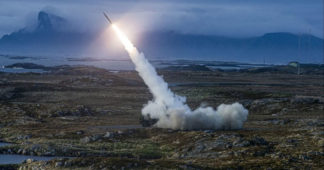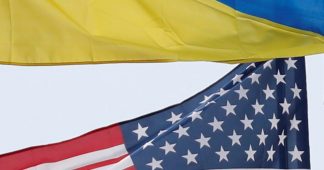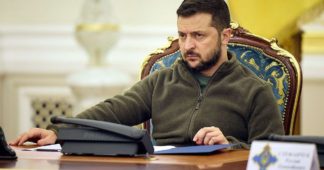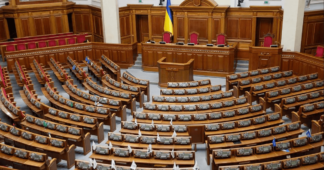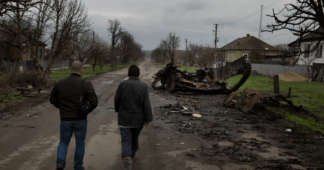By Dmitri Kovalevich *
Aug 20, 2023
In Western media, the current conflict in Ukraine is often presented as a war between Western-style ‘freedom and democracy’ and Russian-style ‘authoritarianism and dictatorship’. We are told, furthermore, that such ‘freedom and democracy’ are represented by the governing regime in Kiev.
But this is a regime that has banned all men between the ages of 18 and 60 as well as women in certain professions from leaving the country. There is no free internal movement of citizens. The main exceptions to the prohibition on leaving the country are those unfit for military service, those fathers who have three or more minor children (all below the age of 16), and persons caring for people with disabilities. (The latter exemption only applies if there is no other family member to provide care.)
The regime, which came to power in a violent coup in February 2014, has long ago banned all left-wing political parties in the country, and since last year it has banned street protests and strikes. Also last year, it passed a law severely restricting the rights of trade unions. Ukraine was supposed to hold a legislative election this fall, but this has been postponed. (Elections are to take place in the Russian-controlled territories of Ukraine on September 8-10). For neoliberal capitalism, there can never be too many restrictions against freedom, nor can there ever be too much exploitation.
In early August, deputies of the Ukraine president’s ‘Servant of the People’ party in the national legislature (‘Rada’) introduced a bill that provides for the conscription of forced labor of all those who have not been conscripted to the armed forces. Formally free citizens who already cannot legally leave the country due to wartime restrictions will now also be subjected to forced labor.
Labor shortages amid wartime conditions
There is also already a serious shortage of trained personnel in Ukraine. Hundreds of thousands of factory workers, skilled tradespeople, railway workers, drivers, and other equipment operators in agricultural industries, and on and on have been conscripted into the army. Many of them have died or been seriously injured in the futile attempts of Ukraine’s leaders and their Western patrons to storm the well fortified defensive lines of the Russian armed forces.
In addition, some eight million people have simply left the country during the past year and a half. Most of those have no wish or plans to return in any foreseeable future. Every day, Ukrainian border guards catch dozens of ‘conscription refugees’ at Ukraine’s borders. Sometimes, border officials use tracking drones generously provided by the governments of the European Union and the United States. The unfortunates who are caught quickly find themselves in the trenches along the hundreds of kilometers of front lines separating Ukrainian and Russian armies.
‘Help wanted’ signs can be seen in Ukraine on many delivery trucks, at bus stops, and in front of supermarkets. Orderlies and drivers, construction workers and packers read the signs, are “urgently needed for work”.
Although Ukraine is the poorest country on the European continent, many people are not eager to rush into a job. Since the beginning of the year, company managers are obliged to hire employees only after receiving formal approval from the local military conscription office. Thus, a man who applies for an advertised job as a driver may well instead find himself in the trenches, facing minefields and deadly Russian defensive positions. Meanwhile, his former employer will be back on the hustings looking for a replacement driver.
Salary reductions widespread
Another factor weighing on the labor market in Ukraine is wage reductions of up to 50 per cent. Teachers are facing salary cuts as the 2023 national budget for public education in Ukraine has been downgraded from an initial 154 billion hryvnias to 131 billion hryvnias (US$3.5 billion). That is less than the 2022 expenditure. In addition, most school districts rely on supplementary funding from local governments, and these funds, too, are being squeezed. As the Ukrainian news outlet Apostrophe explained in a report in late 2022, citing a teacher in Kiev named Oksana: “In Kyiv, the situation is more or less the same, although the allowances have been partially removed. But the situation elsewhere in Ukraine is really worse. In many cities and villages, teachers are receiving ‘survival’ salaries only, losing from 15 per cent all the way to 50 per cent of their income, depending on the state of local budgets.”
The report explains, “Educators receive money not only from the Ministry of Education and Culture but also from local budgets. But local budgets during the war have also shrunk significantly. According to a study by the Kyiv School of Economics, every fourth community under [Russian] occupation [control] has collected 50 percent less revenue compared to pre-war plans. Another two-thirds of communities outside the combat zone reported a decrease in income. It is clear that in such a situation when it is necessary to urgently address humanitarian issues, local authorities cannot pay pre-war salaries to teachers.”
This takes place as inflation is around 30 percent annually. Wages in Ukraine today barely cover the cost of basic food. For these reasons and more, many workers retreat into the shadows and choose to work illegally, many in multiple jobs if possible.
Last year, Ukrainian authorities tried to solve their labor shortage problems by tapping into the large pool of the unemployed. The unemployed who were officially registered were sent into military zones to clear rubble, cut down trees, build shelters, etc. This is hard physical work, often located near the front lines. This initiative was labeled an ‘Army of Reconstruction’, but many people responded by simply stopping to register as unemployed. After all, unemployment benefits have also been cut in Ukraine. Today, the average benefit hovers around the equivalent of US$27 per month. The maximum benefit rate is $180 per month, but this is only good for three months.
Food prices in Ukraine are already higher than in Russia and EU countries, from where most food supplies in Ukraine come.
A new system of slave labor taking root
Simply put, Ukraine is gradually introducing a system of slave labor – people must work to meet basic food needs, but they work for steadily shrinking salaries and benefits. Western media is silent about all this but is happy to continue preaching about the ‘Gulag Archipelago’ of the former Soviet Union where millions toiled without receiving wages or financial benefits in return.
The new draft law on the mobilization of workers is intended to “ensure the functioning of the national economy under martial law”, in the words of those drafting the law. It is noteworthy that in early August, Ukraine began to talk about a likely ban against military conscripts leaving the country for three years following an eventual end to military hostilities and martial law. Just such a proposal was recently made by Vadym Denysenko (and here), head of the Ukrainian Institute for the Future and a former advisor to the head of the Ukrainian Ministry of Internal Affairs. Denysenko said, “I am sure that even after the war it will be necessary to extend the ban on men traveling abroad for at least another three years. Otherwise, we simply will not survive as a nation.”
Severe drop in population numbers
Earlier, Denysenko’s Ukrainian Institute for the Future published data on population numbers in Ukraine. Since the start of the Russian special military operation in Ukraine 18 months ago, some 8.6 million citizens have left the country and not returned. Of the 29 million citizens remaining in the country, no more than 9.5 million are working. State-financed jobs excluded, there are some six to seven million workers earning salaries. Ukraine began its path to post-Soviet ‘independence’ in 1991, with a population of 52 million. The population numbers have been steadily declining ever since due to mass emigration.
At the same time, the fertility rate of the country has fallen below one. To ensure stabilisation and a small increase of the population, the fertility rate should be more than 2. But the Institute says the average fertility rate is 0.7 children per couple. It also cites analysts who project that the number of pensioners in Ukraine in the coming years will be double the number of working-age citizens.
Vadym Denysenko is partly right in the sense that millions of Ukrainian men would no doubt rush abroad were borders to be opened. The wives and children of many of them have already been living abroad for year and a half. Many would leave in search of better wages and in order to escape the mousetrap that Ukraine has become.
Denysenko’s proposal is not at all appreciated in Ukraine. It is viewed as a return to slavery and serfdom. Of particular note is that his Ukrainian Institute for the Future is a neoliberal think tank funded by right-wing think tanks in the West, including the Atlantic Council and the National Endowment for Democracy in the United States.
This idea of prohibiting Ukrainian citizens from leaving the country even after the end of hostilities stems, in part, from the fact that Ukraine is now heavily indebted to Western governments and financial institutions. Repayment with interest can only be guaranteed through the merciless exploitation of the Ukrainian population. To achieve that, it is necessary that the population be denied the option of running away from something rightly perceived as something resembling slavery or medieval serfdom.
In July 2023, the foreign exchange reserves of the National Bank of Ukraine grew by 6.9% to $41.7 billion, the highest monthly increase since 1991. However, the largest share of the increase came not from economic growth and increased export revenues but from international assistance to the tune of $4.7 billion. Most of that comes in the form of loans from the European Union, the United States, Japan, the IMF, and the World Bank, to be repaid in the future.
Bloomberg News reported on July 24 that Ukraine needs to bring back 2.8 million of its women citizens from abroad in order to have a chance at economic recovery following the end of military hostilities. According to one expert Bloomberg interviewed, if only half of the women return, this would cost Ukraine 10% of its GDP by 2032, on the order of $20 billion per year. Such losses will far outweigh the EU’s proposed four-year aid package to Ukraine in the amount of $14 billion per year.
According to a recent estimate by the Ukrainian Ministry of Economy, Ukraine will need to attract an additional 4.5 million workers to the labor market over the next ten years. But at current wage levels, people are more likely to leave the country than to stay and work.
Ukrainian journalist Diana Panchenko wrote on her blog earlier this month, “At the end of the war, a huge number of people will still leave. Ukrainians will be scattered all over the world, like the Roma people, for example.” She has been forced to flee Ukraine due to her writings critical of the government. She also noted in her blog post that, according to UN statistics, most Ukrainians who have left the country have settled in Russia. “It is not customary to talk about this in Kyiv, and the reason for that is clear.”
Answering a reader asking when the refugees could return to Ukraine, the journalist replied that, in her opinion, it would not be soon, the war could last a long time. Clearly, this will not help boost population growth. And how will it all end? Few in Ukraine can openly say this, but, according to Panchenko, “Ukraine has already lost – we have no economy and, even worse, we have no sovereignty. Today, we simply depend on what the West says. We have lost our identity.”
At the end of July, Ukrainians were also apprised of a stunning proposal that the working week may be increased to 60 hours, consisting of six days of work at ten hours per day or five days at 12 hours. At least, that is the idea published by the Eastern interregional office of the State Service of Ukraine on Labor Issues. The duration of weekly, uninterrupted rest would be reduced to 24 hours, that is, Ukrainians will have only Sunday as a day of rest from work. This idea would first be implemented in enterprises working in critical infrastructure or “defense”. The increase in the work week is said to be required by the shortage of workers and the need to constantly repair energy infrastructure.
As it stands presently, employers often exploit Ukrainian workers beyond the norms that would be established by this law. Recently, this same State Service of Ukraine on Labor Issues was approached by an employee whose employer set the rest period for the preceding month as only one day every three weeks and the duration of the shift as 12 hours. The employer claims that such a schedule will be in effect until the end of the year because, during martial law, the number of overtime hours required to work can be unlimited.
Thus, for the average Ukrainian, the Western values of freedom and democracy are turning into an unprecedented neoliberal experiment to abolish all labor rights and implement something resembling slavery. Measures to force Ukrainians to ‘fight or work’ are presented as a triumph of oft-spoken “European values”.
The secretary of Ukraine’s National Security and Defense Council, Oleksiy Danilov, is not even afraid to make racist interpretations of these ‘values’. In early August, he called Russians “Asians”. According to him the hallmark of the Russian people is their lack of humanity, and in this, they are said to resemble Asian people. Western advisors, of course, normally advise Ukraine’s leaders to carefully conceal such racist or neo-Nazi views in order to help win countries in the Global South to support NATO aggression against Russia. But Ukrainian leaders are not always successful in holding themselves back.
In the future that Ukrainian politicians and their Western advisors and think tanks are preparing, many Ukrainians will work up to 12 hours a day with few days off, earning less than a minimum subsistence salary. They won’t dare flee their country because the consequences of being caught could easily become deadly.
European slave traders once captured slaves in Africa and transported them in bondage to the Americas and other far-flung destinations. They could not come up with a more forceful and chilling display of what their modern-day ‘freedom and democracy’ truly means.
* Dmitri Kovalevich is the special correspondent in Ukraine for Al Mayadeen English. He writes monthly situation reports as well as occasional special reports, including the following.
We remind our readers that publication of articles on our site does not mean that we agree with what is written. Our policy is to publish anything which we consider of interest, so as to assist our readers in forming their opinions. Sometimes we even publish articles with which we totally disagree, since we believe it is important for our readers to be informed on as wide a spectrum of views as possible.
